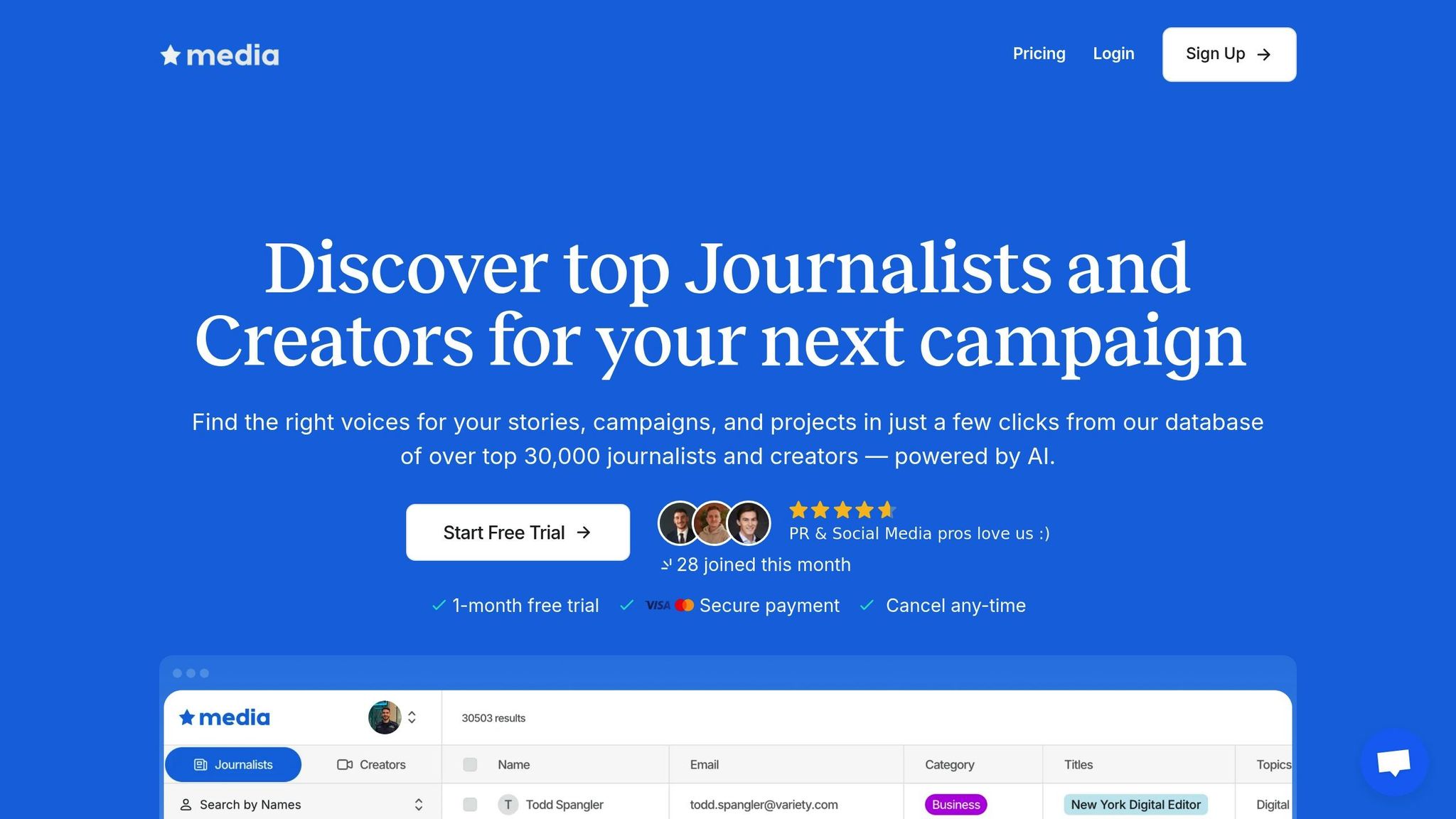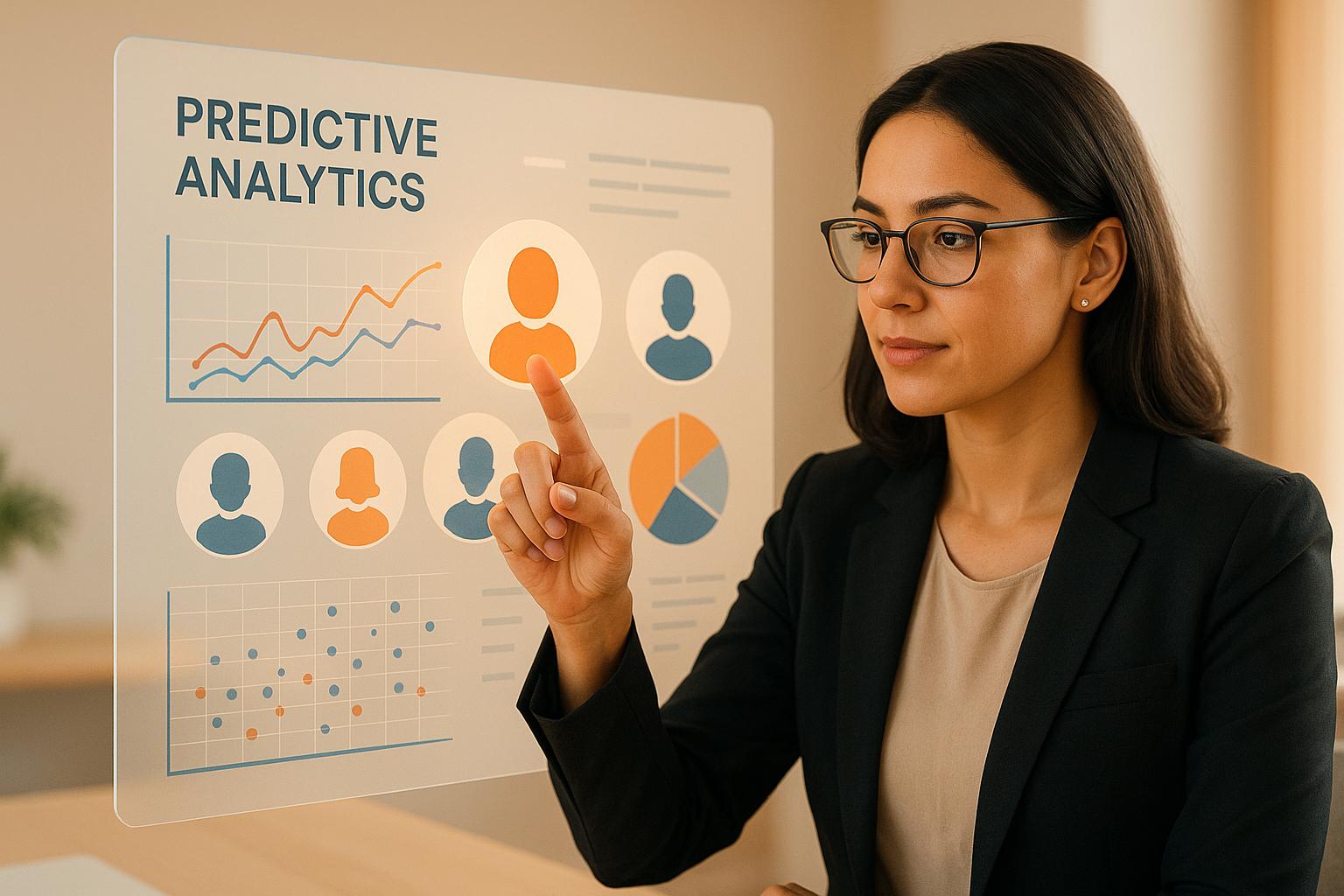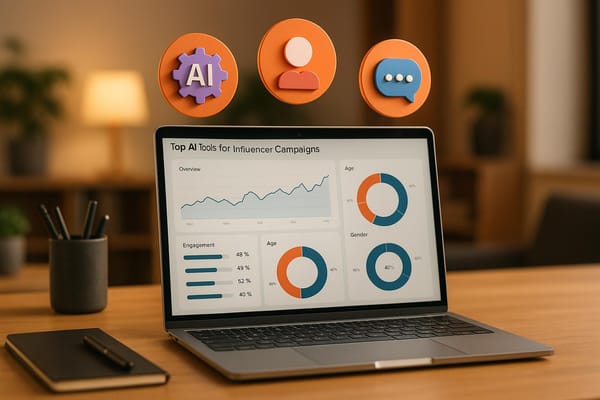How AI Transforms Competitor Media Monitoring
Explore how AI is revolutionizing competitor media monitoring with real-time insights, sentiment analysis, and predictive analytics for strategic advantage.

AI is changing how businesses monitor competitors and manage media coverage by automating complex tasks and delivering real-time insights. Here's what you need to know:
- Real-Time Insights: AI tools track competitor mentions, sentiment, and emerging trends instantly, helping teams respond faster.
- Sentiment Analysis: AI evaluates whether coverage is positive, negative, or neutral, providing deeper insights into public perception.
- Predictive Analytics: By analyzing historical data, AI forecasts trends and audience behavior, enabling proactive decision-making.
- Benchmarking: AI compares your brand's performance against competitors across multiple platforms, including social media, news, and video.
- Media AI Tools: Platforms like Media AI simplify journalist targeting, competitor tracking, and campaign benchmarking with affordable pricing starting at $99/month.
Key Benefits:
- Save time by automating data collection and analysis.
- Gain competitive advantages with faster, data-driven strategies.
- Ensure accuracy by filtering out bots and irrelevant data.
AI is reshaping PR strategies, making competitor monitoring more efficient and actionable. Ready to stay ahead of the competition?
How to Build an AI AGENT That Monitors Everything Your Competitors Do
AI Advances in Competitor Media Monitoring
In a crowded media environment, the demand for real-time, actionable insights has pushed PR teams to rely on AI for deeper competitor analysis. These advancements go far beyond just tracking keywords, offering detailed insights that were once out of reach.
Automated Sentiment Analysis and Media Tone Insights
AI-powered sentiment analysis has completely changed how PR teams interpret the emotional tone surrounding their competitors. Instead of simply counting mentions, these tools evaluate whether coverage leans positive, negative, or neutral, factoring in the context and subtleties of language. This provides a much clearer picture of public perception.
By processing vast amounts of data from social media and news outlets, AI uncovers emerging topics and tracks sentiment shifts in real-time. These systems are precise enough to pick up on subtle tonal changes. As Brand Strategist Phil Pallen explains, analyzing sentiment trends over time helps PR teams understand what strategies succeed and where adjustments are needed.
This capability is powered by natural language processing (NLP) and machine learning algorithms, which allow AI systems to engage with human language and improve their accuracy over time. The result? Faster, more refined sentiment insights that are immediately actionable.
Real-Time Tracking and Alerts
Real-time monitoring has redefined how efficiently businesses can track competitors. AI-driven systems send instant alerts for specific keywords, brand mentions, or competitor product launches. This allows companies to respond quickly to breaking news or trending discussions, a critical advantage in managing public relations.
These tools also provide immediate updates on changing customer sentiment, enabling PR teams to act strategically without waiting for traditional reporting cycles. With approximately 65% of PR professionals already using AI tools, many identify continuous monitoring as a game-changer for competitive intelligence. The constant flow of data also lays the groundwork for predictive analytics, enhancing decision-making even further.
Predictive Analytics for Decision-Making
Predictive analytics is one of the most advanced tools in competitor monitoring. By analyzing historical data, AI can forecast trends, helping PR professionals understand customer behavior, define target audiences, and maintain a competitive edge. For example, AI can analyze patterns in competitor social media activity, press releases, and marketing campaigns to identify trends before they gain widespread attention.
These predictive models also differentiate between customer segments engaging with a brand versus its competitors, with 66% of businesses reporting high value from these tools and a median ROI of 145%. Adoption is accelerating, with 80% of PR professionals expecting to use AI tools by 2026. By anticipating audience shifts, predictive analytics enables PR teams to adjust strategies proactively - often staying ahead of competitors who are slower to recognize new opportunities.
Benchmarking Competitor Media Coverage with AI
With the rise of real-time tracking and predictive insights, benchmarking has become a critical tool for refining competitive intelligence. AI-powered benchmarking allows PR teams to measure their performance against competitors with speed and precision. Considering that brands are mentioned online every 3.2 seconds and with over 2.5 million online publications expected by 2025, traditional monitoring methods just can't keep up. This advanced approach integrates data from multiple channels, providing deeper, comparative insights.
Multi-Channel Data Analysis
Modern AI tools pull data from a variety of platforms to create detailed competitor benchmarks. These tools monitor activity across social media networks like Facebook, Instagram, X, YouTube, TikTok, and LinkedIn, as well as traditional media sources such as news sites, blogs, and podcasts. AI algorithms not only track the context and sentiment of mentions but also identify trends in real time, filter out irrelevant data, and even detect bot-generated activity.
AI has also moved beyond just analyzing text. It now includes video and audio monitoring, offering capabilities like transcribing audio, interpreting visual content, and analyzing emotions in videos. On top of that, these tools provide customizable dashboards that cater to different departments. For example, marketing teams can focus on engagement metrics, while PR teams zero in on sentiment and reputation indicators.
Key Metrics for AI-Powered Benchmarking
AI benchmarking transforms the vast amount of data it collects into actionable insights, going beyond basic mention counts. Here are some of the key metrics that drive strategic decision-making:
- Share of Voice: Tracks the percentage of the overall conversation a brand captures compared to competitors.
- Sentiment Analysis: Categorizes media mentions as positive, negative, or neutral, offering a clear picture of public perception.
- Presence & Reputation Scores: Measures a brand's visibility and overall perception in the market.
- Geo Analysis: Identifies regional variations in brand perception and competitor performance.
These metrics aren’t just numbers - they translate into real-world results. For instance, during San Diego Comic-Con 2022, Brand24's AI detected 42,000 social media mentions for Marvel, capturing 10 million interactions, 680,000 shares, and reaching an audience of 816 million. Tools like AIM Insights use natural language processing and machine learning to analyze millions of data points daily, offering insights that go far beyond simple data tracking.
In December 2024, AI tools identified a spike in mentions for Reebok, linking the data to practical recommendations. These insights also enable PR teams to dig deeper by segmenting analysis by product category or service vertical, identifying patterns in competitors’ publishing schedules, and even planning counter-campaigns when competitor visibility drops.
Perhaps the most powerful feature of AI benchmarking is its predictive ability. By forecasting trends before they fully develop, these tools give PR teams a head start during crises or market shifts, enabling them to adapt their strategies in advance.
Media AI: Changing Competitor Media Monitoring

Media AI combines the power of artificial intelligence with targeted relationship-building to transform how competitor media monitoring is done. By leveraging AI's strengths in real-time tracking and sentiment analysis, Media AI takes things a step further by focusing on building connections through key media channels. This approach not only enhances tracking but also sets the stage for smarter campaign benchmarking.
Key Features and Benefits of Media AI
Media AI offers a database of over 30,000 journalists and creators, giving PR teams the tools to identify the key players behind competitor conversations.
The platform's advanced filtering options make it easy to sort journalists by beat, publication type, audience size, and location. This level of detail helps PR professionals pinpoint influential media figures and analyze sentiment trends in competitor coverage.
Real-time updates ensure teams can act quickly when competitor news breaks. For instance, if a journalist publishes a critical article about a competitor, Media AI provides verified contact details instantly, allowing PR teams to respond or engage without delay.
The user-friendly interface makes it simple to set up workflows for monitoring competitors. Instead of spending hours configuring systems, PR professionals can get everything running in minutes, leaving more time for strategic planning.
How Media AI Simplifies Campaign Benchmarking
Media AI doesn’t just stop at monitoring - it enables PR teams to actively build relationships with journalists who frequently cover competitors. By exporting targeted media lists, teams can establish connections and tailor pitches based on proven coverage patterns.
Understanding the media landscape surrounding competitors allows teams to approach campaign optimization more strategically. Media AI highlights which journalists and creators have strong ties to competitor brands, opening doors to new connections and improving influencer marketing efforts.
Pricing and Access
Media AI offers a straightforward, contract-free pricing structure designed to meet the needs of PR teams, agencies, and freelancers.
- Journalist Database Plan: $99 per month for access to over 30,000 journalists, complete with advanced filtering and export tools.
- Creators Database Plan: $99 per month for full access to 30,000+ creators and influencers, along with targeting features.
- Full Database Plan: $149 per month for combined access to both datasets, offering comprehensive coverage without any restrictions.
| Plan | Monthly Price | Database Access | Key Benefits |
|---|---|---|---|
| Journalist Database | $99 | 30,000+ journalists | Advanced filtering, export tools, no contracts |
| Creators Database | $99 | 30,000+ creators | Full access, targeting tools, flexible terms |
| Full Database | $149 | Complete database | Combined access, broader coverage, maximum flexibility |
This pricing model removes the uncertainty of usage-based fees, allowing PR teams to focus on building relationships rather than worrying about costs. The no-contract option is especially helpful for agencies and freelancers who need flexibility during client campaigns, enabling them to scale their efforts as needed without long-term commitments.
Future Trends in AI-Powered Media Monitoring
AI is not just about tracking and benchmarking anymore - it’s evolving into a game-changer for competitor monitoring and reputation management. With the ability to analyze visuals and predict reputational risks, AI is reshaping how businesses keep tabs on competitors and protect their image. Interestingly, 86% of PR professionals worldwide already see AI as a transformative force in their field. And it’s not stopping there - AI is moving beyond text and diving deep into visual media and reputation forecasting.
Enhanced Visual Content Analysis Across Platforms
One of the most exciting developments in AI-powered media monitoring is its growing ability to analyze visual content. Advanced AI models can now detect emotions, objects, and contextual details in images and videos, offering a deeper understanding of competitor strategies.
Take Coca-Cola, for example. The company uses AI to monitor its logo across social media photos. This technology doesn’t just spot logos; it can also identify brand elements and even gauge emotional reactions through facial expressions in competitor content. On top of that, sophisticated video tools can extract key moments, transcribe speech, and analyze how competitors visually present their messages.
Real-time video analytics is another area gaining momentum, providing instant insights from live-streamed events and competitor interactions. And as deepfakes and manipulated visuals become more common, emerging AI models are stepping up with tools to detect these alterations, ensuring that PR teams can trust the data they’re analyzing.
AI's Expanding Role in Reputation Management
AI is taking reputation management to the next level by shifting the focus from reactive crisis handling to proactive threat prevention. Predictive analytics, for instance, has helped 72% of PR professionals using it report better crisis prevention outcomes.
AI-powered systems are also proving to be more effective at capturing relevant mentions - 37% more than traditional methods. This ensures that businesses don’t miss critical competitor activities or potential threats. However, concerns remain: 63.9% of PR professionals worry about fake news, 32.8% about AI-generated bias, and 37.8% about data privacy.
"AI will help create hyper-personalized stories and even automate investigative tasks while enhancing human oversight and upholding ethical standards." - Vineet Gupta, Founder of 2xsas
While AI can process patterns and data at incredible speeds, human judgment is still essential for strategic decisions and maintaining ethical standards. Currently, 65% of PR professionals incorporate AI into their work, but success depends on ongoing education and responsible use. Advanced AI tools are also enabling audience segmentation and predictive analytics, giving PR teams the ability to anticipate how different groups might react to competitor actions or potential crises. This paves the way for more precise and impactful reputation management strategies.
Conclusion: The Future of Competitor Media Monitoring
AI is reshaping how PR professionals handle competitor media monitoring, turning what was once a reactive process into a proactive, strategic approach. With projections showing over 4.9 billion people using social media by 2025, keeping up with competitor activities has become increasingly challenging. But AI steps in to simplify this complexity, offering real-time insights and actionable intelligence.
This transformation is already underway. Tools powered by AI, like real-time sentiment analysis, predictive analytics, and automated alerts, are helping PR teams stay ahead of their competitors. Platforms such as Media AI illustrate this change, providing quick access to extensive databases and advanced filtering tools that allow teams to respond swiftly and effectively to competitor movements.
Organizations are adapting their strategies to embrace these advancements. A staggering 94% of data and AI leaders report that the growing interest in AI is sharpening their focus on data-driven strategies. By integrating AI into their monitoring efforts, companies can spot emerging trends early and mitigate potential reputation risks before they escalate.
The future of media monitoring promises even more sophistication. Upcoming innovations are expected to include voice and video sentiment analysis, predictive brand health scoring, and AI-driven crisis simulations. Enhanced visual content analysis will also evolve, moving beyond basic logo detection to recognizing emotions and understanding context across platforms. These advancements highlight the critical role of platforms like Media AI in preparing PR teams to meet future challenges.
"Organizations have a competitive edge to operate more efficiently and adapt to market changes faster than competitors."
- Jim Chilton, Chief Technology Officer at Cengage Group
FAQs
How does AI make competitor media monitoring more accurate and efficient than traditional methods?
AI is changing the game in competitor media monitoring by taking over tasks like collecting, analyzing, and reporting data - jobs that used to eat up a lot of time and were often prone to mistakes. By processing massive amounts of information from countless sources in real-time, AI delivers insights faster and with greater precision.
These tools go beyond just speed and accuracy. They can identify trends, gauge sentiment, and reveal patterns that manual methods might overlook. For PR teams, this means making smarter decisions, measuring competitors more effectively, and staying ahead of market shifts. It’s a powerful way for organizations to stay one step ahead.
What AI features should businesses prioritize when selecting a media monitoring platform?
When selecting a media monitoring platform, businesses should focus on AI-powered tools that boost both efficiency and insight. Key features to look for include real-time tracking, multi-platform coverage, and sentiment analysis - all crucial for keeping tabs on brand mentions and understanding public perception. Tools offering topic clustering, trend spotting, and early issue detection can give you a competitive edge by helping you respond quickly to market changes.
For PR teams and marketers, platforms like Media AI offer a powerful combination of AI-driven analytics and access to a vast database of over 30,000 journalists and creators. This makes it easier to manage PR campaigns and connect with the right partners. By using these smart tools, businesses can make sharper decisions and enhance their media monitoring efforts.
How does AI-powered predictive analytics help PR teams anticipate trends and outpace competitors?
AI-driven predictive analytics gives PR teams a significant edge by spotting upcoming trends and predicting competitor moves. By digging into historical data, media coverage, and social media activity, AI can reveal patterns and subtle market changes that might slip under the radar.
This information empowers PR professionals to act early, fine-tune their messaging, and design campaigns that hit the mark. Tools like Media AI make it easier to streamline workflows, allowing teams to concentrate on crafting strategies that connect with their audience and outpace the competition.





